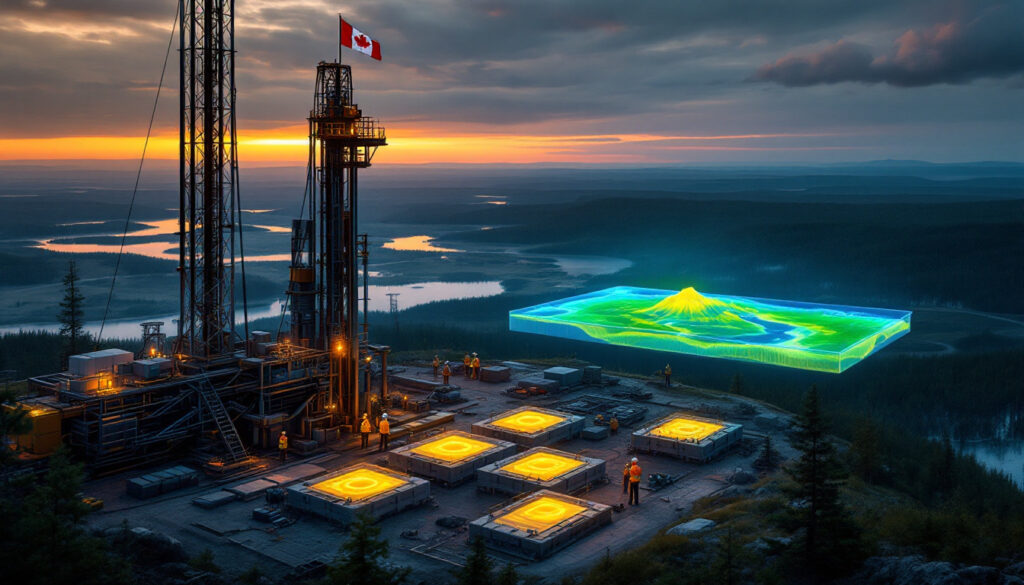Understanding the Discovery-to-Resource Timeline
The journey from initial uranium discovery to a defined resource estimate typically takes about 2.5 years on average, based on historical projects in the Athabasca Basin. This timeline can vary significantly depending on deposit complexity, company resources, and exploration approach. For example, the Kianna deposit took approximately 5 years to define, while others like Phoenix and Roughrider were defined in less time with fewer drill holes.
Modern resource estimates in uranium exploration and resource estimation generally require more extensive drilling than in previous decades. While earlier projects might have established resources with 40-50 drill holes, today's standards often require around 80 holes before companies announce resource estimates. This reflects a growing industry preference for higher confidence classifications (measured and indicated) rather than relying heavily on inferred resources.
"If they're drilling only for promotional results rather than systematically defining the resource, they're wasting money," notes Chris Frostad, VP Exploration at Purepoint Uranium Group. "You should see an intelligent approach: regular updates explaining how the resource is expanding."
The Financial Investment Required
The path to a resource estimate represents a substantial financial commitment. Companies typically invest approximately $50 million to properly define a uranium resource in the Athabasca Basin. This significant expenditure covers not only the drilling program but also the extensive analytical work, geological modeling, and technical studies required to establish a compliant resource estimate.
The costs can escalate quickly, especially in deep deposits where each drill hole may cost $500,000 or more. This financial reality creates a significant barrier to entry and explains why many junior companies struggle to advance projects beyond initial discovery. Recent changes in the industry have also been affected by uranium mining updates that influence investment decisions.
Balancing Exploration and Definition Drilling
Successful uranium companies must strategically balance their drilling budgets between:
- Confirmation drilling – Systematically defining the extent and continuity of mineralization
- Exploration drilling – Testing new targets to potentially expand the resource base
- Infill drilling – Increasing confidence in the resource classification
This balance directly impacts both the timeline to resource definition and the quality of the resulting estimate. Companies must resist the temptation to focus exclusively on "zinger" holes (exceptionally high-grade intersections) for promotional purposes at the expense of methodical resource definition.
The methodical approach involves starting with widely-spaced holes, followed by systematic step-outs to define mineralization boundaries, and finally infill drilling to establish continuity. Projects like Hook Lake demonstrate this discipline, with Purepoint focusing on 10-12 strategic holes before determining economic viability rather than drilling randomly for promotional purposes.
Who Creates Credible Resource Estimates?
The Role of Qualified Persons (QPs)
Resource estimates must be prepared or supervised by Qualified Persons (QPs) – professionals with relevant experience and qualifications who take legal responsibility for the technical information. These experts typically have:
- Professional designations in geoscience (P.Geo) or engineering (P.Eng) in Canada
- Minimum 5+ years of experience specifically in uranium deposit evaluation
- Specialized knowledge of the specific deposit type
- Independence from the company (for maximum credibility)
As Chris Frostad points out, "Major companies like Cameco and Orano put significant pressure on QPs to avoid signing off on resource estimates that aren't thoroughly supported by data." This industry pressure, combined with regulatory scrutiny, has raised the bar for professional standards in resource estimation.
Industry Standards and Protocols
Credible resource estimates follow established protocols and standards aligned with the Canadian Institute of Mining, Metallurgy and Petroleum (CIM) Definition Standards:
- Systematic drilling approaches – Using appropriate drill spacing (typically 50-100m grids initially) and orientation
- Quality assurance/quality control (QA/QC) – Rigorous sampling protocols including blind standards insertion (1:20 samples) and third-party verification at labs like SRC Geoanalytical
- Geological modeling – Creating three-dimensional representations of the mineralization
- Geostatistical analysis – Applying appropriate estimation methods such as inverse distance weighting or kriging
- Cut-off grade determination – Establishing economic parameters
- Classification criteria – Applying industry-standard confidence categories
The increasing scrutiny from regulatory bodies has resulted in more conservative approaches to resource classification, with companies conducting more drilling before announcing resource estimates compared to previous market cycles. Understanding proper drill results interpretation is crucial for evaluating these estimates.
Modern QPs must navigate complex trade-offs between statistical confidence, geological interpretation, and economic reality. For example, NextGen's Arrow Deposit utilized independent QPs from Roscoe Postle Associates to ensure credibility for its world-class resource estimate.
How Does Infrastructure Impact Resource Development?
Eastern vs. Western Athabasca Basin
Infrastructure availability creates significant differences between the eastern and western portions of the Athabasca Basin:
Eastern Basin Advantages:
- Established road networks within 50km of major deposits
- Access to power infrastructure
- Proximity to existing mills (McClean Lake, Key Lake)
- Shorter permitting timelines (3-5 years faster)
- Lower development costs
Western Basin Challenges:
- Limited transportation infrastructure
- Power generation requirements
- No operating processing facilities
- Longer permitting processes
- Higher capital expenditure requirements (2-3x higher than eastern projects)
While significant uranium resources exist in the western basin (including the Triple R, Arrow, and Shea Creek deposits), their development faces additional hurdles compared to eastern basin projects.
Cameco's Cigar Lake operation demonstrates the advantage of eastern infrastructure, leveraging existing road networks for development. In contrast, NexGen's Rook I project in the western basin faces an estimated $1.3 billion in pre-production capital expenditures largely due to infrastructure requirements.
The Processing Facility Challenge
The availability of uranium processing facilities represents a critical consideration:
- Existing mills have limited capacity and are not generally available for toll milling
- New deposits either require their own processing facilities (significant capital cost)
- Or must be attractive acquisition targets for companies with existing infrastructure
This reality shapes company strategies, with many explorers positioning their discoveries as potential acquisition targets rather than standalone development projects.
"You either build your own mill or become an acquisition target for majors with infrastructure," explains Frostad. "This is why location matters so much in uranium project economics."
The processing challenge is particularly acute for smaller deposits (under 50 million pounds), which typically cannot justify standalone facilities but must rely on strategic proximity to existing infrastructure for potential development.
What Exploration Strategies Lead to Successful Resource Estimation?
Methodical Exploration Approaches
Successful uranium exploration companies follow systematic approaches, with less than 5% of uranium prospects ultimately reaching resource stage:
- Target identification – Using geophysics (gravity/EM surveys), geochemistry, and geological modeling paired with historical drilling data
- Initial drilling – Testing priority targets with widely-spaced holes (50-100m grids)
- Follow-up drilling – Systematic step-outs to define mineralization extents
- Resource definition – Infill drilling to establish continuity and grade distribution
Companies must resist the temptation to focus exclusively on headline-grabbing high-grade intersections and instead commit to methodical exploration programs that systematically evaluate the deposit's potential. Careful exploration investment strategies are essential for maximizing return on capital.
Purepoint's Smart Lake Project exemplifies this approach, with a focused 3-hole program informed by legacy data before making expansion decisions. This "drill to kill" philosophy acknowledges that it's better to quickly determine a target's lack of economic potential than waste resources on marginal prospects.
Balancing Promotion and Progress
Public companies face the challenge of maintaining market interest while conducting the methodical work required for resource definition. This often leads to:
- Premature discussion of resource estimates before sufficient drilling
- Overemphasis on individual high-grade intersections
- Unrealistic timelines for resource definition
Investors should be wary of companies that immediately discuss resource estimates or production scenarios after only a handful of drill holes, as this indicates a promotional focus rather than a commitment to rigorous resource definition.
"Drill to kill – there's no point spending $500k per hole on subeconomic targets," advises Frostad. "The market rewards companies that show intelligent, systematic approaches to resource definition."
Modern exploration increasingly incorporates advanced technologies like machine learning for target generation, though the industry has been slower to adopt these tools than other mining sectors. Companies at the forefront of technological adoption often gain competitive advantages in discovery efficiency.
What Are the Exit Strategies for Uranium Exploration Companies?
Acquisition by Major Producers
The most common exit strategy for uranium exploration companies is acquisition by established producers:
- Cameco and Orano – Primary acquirers in the Athabasca Basin
- Acquisition criteria – Typically seeking deposits with potential for 100-150 million pounds
- Timing considerations – Acquisitions often occur at resource definition stage, before development
- JV prevalence – Approximately 60% of Athabasca projects have major/minor partnerships
This strategy requires discovering deposits that align with the strategic needs of potential acquirers, considering factors like size, grade, depth, and proximity to existing infrastructure.
Recent examples include IsoEnergy's Hurricane Deposit, acquired by Consolidated Uranium in 2023, demonstrating the continued appetite for high-quality uranium assets from established players. Acquisition premiums have fluctuated significantly with uranium market volatility, making timing a critical consideration for exit strategies.
Development Partnerships
Some exploration companies pursue joint ventures or partnerships to advance projects:
- Risk sharing – Distributing the financial and technical risks
- Complementary expertise – Combining exploration and development capabilities
- Staged investment – Allowing gradual commitment as the project advances
These arrangements can provide a pathway to development without requiring outright acquisition.
Denison's Wheeler River project exemplifies this approach, with partnerships involving Orano and JCU (Japan) to distribute risk while maintaining significant project control. Such structures allow junior companies to advance projects beyond what their balance sheets might otherwise permit.
Transition to Developer/Producer
The rarest exit strategy involves the exploration company transforming into a developer and eventually a producer:
- Requires significant capital – Hundreds of millions to billions in development funding
- New expertise – Different management skills and technical capabilities
- Longer timeline – Extended period before revenue generation
This transition is exceptionally challenging in the uranium sector due to the specialized nature of uranium mining and processing, regulatory complexities, and substantial capital requirements.
"Canadians are great at raising money, but transitioning to producers requires different DNA," notes Frostad, highlighting the significant shift in organizational capabilities required.
While uncommon, this path isn't impossible – NexGen Energy's progression from explorer to developer with its Arrow project demonstrates that well-capitalized companies with exceptional assets can make this transition, though the journey remains challenging.
How Should Investors Evaluate Uranium Exploration Companies?
Key Assessment Criteria
Investors should evaluate uranium exploration companies based on:
- Technical approach – Systematic exploration methodology vs. promotional drilling
- Infrastructure proximity – Eastern vs. western basin considerations
- Management experience – Track record in uranium exploration and development
- Financial capacity – Ability to fund comprehensive exploration programs
- Strategic positioning – Alignment with potential acquirer interests
- Realistic timelines – Credible paths to resource definition and development
Sophisticated investors look beyond flashy drill results to understand the systematic approach behind a company's exploration program. A methodical, well-communicated strategy for resource delineation often indicates management quality and technical rigor. Understanding deposit classification guides can help investors evaluate the quality of discoveries.
Red Flags to Watch For
Warning signs that may indicate promotional rather than substantive exploration include:
- Premature resource discussions – Talking about resources after only a few drill holes
- Unrealistic timelines – Promising resource estimates within months rather than years
- Exclusive focus on high-grade hits – Drilling only for promotional results rather than systematic definition
- Minimal step-out drilling – Repeatedly drilling the same mineralized zone rather than defining its extents
- Constant promotion without progress – Regular news releases without advancing toward resource definition
Investors should also be wary of companies that emphasize uranium price speculation over deposit quality, as truly exceptional projects maintain value through commodity price cycles. The most successful uranium investments typically combine technical excellence, strategic positioning, and appropriate capitalization.
What Challenges Do Junior Uranium Companies Face?
Technical Challenges
Junior uranium companies face numerous technical hurdles:
- Geological complexity – Uranium deposits often have complex mineralization controls
- Depth considerations – Many deposits occur at significant depths, increasing drilling costs
- Metallurgical complexities – Uranium processing requires specialized expertise
- Environmental considerations – Radiation management and environmental protection
The technical barriers to entry in uranium exploration are substantially higher than in many other commodities. Successful companies typically assemble teams with specific uranium experience rather than general mining backgrounds. For detailed technical information, the IAEA's guidelines for uranium resource estimation provide comprehensive standards.
Financial Challenges
The financial landscape presents additional obstacles:
- High exploration costs – Uranium exploration is capital-intensive, with Athabasca Basin drill holes often costing $500,000+ each
- Extended pre-revenue period – Many years from discovery to potential production
- Cyclical markets – Uranium price volatility affects capital availability
- Specialized investor base – Limited pool of investors with uranium sector knowledge
These financial realities create a challenging environment where only well-capitalized companies can sustain the exploration programs needed to make and define significant discoveries. The cyclical nature of uranium markets means that timing can be as important as technical merit in determining a project's success.
Regulatory and Social Challenges
The uranium sector faces unique regulatory and social considerations:
- Nuclear regulations – Additional oversight beyond typical mining regulations
- Permitting complexity – More extensive permitting requirements
- Public perception – Social license challenges related to nuclear energy
- Indigenous engagement – Important relationships with local Indigenous communities
Successful companies proactively address these considerations early in the exploration process rather than treating them as late-stage development concerns. Early engagement with communities and regulatory bodies can significantly improve project timelines and outcomes. For regulatory background, the World Nuclear Association's uranium resources guide provides valuable context.
FAQ: Uranium Exploration and Resource Estimation
How long does it typically take to define a uranium resource?
Based on historical projects in the Athabasca Basin, the average time from discovery to resource definition is approximately 2.5 years. However, this timeline can vary significantly depending on factors such as deposit complexity, company resources, and exploration approach. Some deposits like Kianna required 5 years for definition, while others like Phoenix were delineated more quickly.
What distinguishes a promotional uranium company from a serious explorer?
Serious uranium explorers follow systematic exploration approaches with methodical drilling programs designed to define deposit extents and continuity. They typically avoid making premature claims about resource potential or production scenarios until sufficient data is available. Promotional companies often focus exclusively on high-grade intersections, make premature claims about resources, and drill primarily for news releases rather than systematic deposit definition.
Why do so few uranium discoveries become mines?
The path from discovery to production faces numerous hurdles, including:
- Economic threshold requirements (size and grade)
- Infrastructure limitations and capital requirements
- Technical challenges in mining and processing
- Regulatory and permitting complexities
- Market conditions and uranium price considerations
These factors collectively result in only a small percentage of discoveries advancing to production. Among uranium prospects that reach the drilling stage, less than 5% ultimately develop into resource-stage projects.
What role do major uranium producers play in exploration?
Major uranium producers like Cameco and Orano maintain exploration programs but often partner with junior companies to access their exploration expertise and spread risk. These majors typically allocate exploration budgets across multiple projects based on strategic priorities. When junior companies make significant discoveries, majors often become acquirers, integrating these discoveries into their production pipelines.
How do infrastructure considerations impact uranium project economics?
Infrastructure availability significantly impacts project economics:
- Transportation access affects construction and operating costs
- Power availability influences processing options
- Proximity to existing mills can eliminate the need for new processing facilities
- Water access impacts processing capabilities
Projects in infrastructure-poor regions face substantially higher capital requirements and longer development timelines. Western Athabasca Basin projects typically require 2-3 times the capital investment of comparable eastern basin projects primarily due to infrastructure limitations.
Further Resources for Uranium Exploration Understanding
Readers interested in learning more about uranium exploration methodologies and resource estimation processes can explore:
- CIM Definition Standards (2014, updated 2019) – Technical guidelines for resource reporting
- Saskatchewan Ministry of Energy and Resources – Geological maps and infrastructure databases
- IAEA's "Uranium Exploration Methods" (2018) – Comprehensive methodology guide
- **Cameco
Ready to Get Ahead of the Next Major Discovery?
Don't miss out on valuable investment opportunities in the uranium exploration sector. Get instant alerts on significant ASX mineral discoveries with Discovery Alert's proprietary Discovery IQ model, turning complex mineralisation data into actionable insights for traders and investors at https://discoveryalert.com.au/discoveries/.




